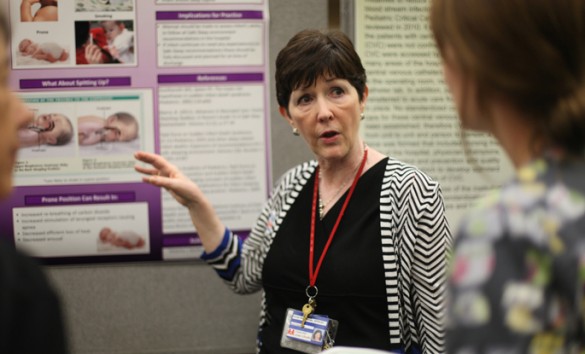
A bright spotlight shone on nursing research at Vanderbilt University Medical Center during the Evidence-Based Practice and Nursing Research Committee’s annual Research Day on Oct. 17.
Part of the weeklong OctoberFest 2012, sponsored by VUMC Nursing Education and Professional Development, Research Day featured breakout sessions, poster presentations and a keynote address by Kristen Swanson, R.N., Ph.D., dean and Alumni Distinguished Professor at the University of North Carolina at Chapel Hill.
“The quality of work done by our nurses continues to improve year after year. I’m tremendously proud of the research that Vanderbilt nurses have done and am excited about this opportunity for them to show off their work,” said Nancy Wells, D.N.Sc., R.N., director of Nursing Research at VUMC.
George Anne Raines, MSN, APRN, presented her poster “The Changing Concept of Sudden Infant Death Syndrome.”
“I’m a nurse practitioner in the NICU, and I’ve had patients die of SIDS or suffocation after they went home. I felt we weren’t doing a good job of educating parents, and we didn’t model sleep behaviors very well on the unit,” Raines said.
She helped develop “Safe Sleep: Back to Sleep” guidelines and participated in the creation of an educational PowerPoint for NICU nursing staff.
“Our protocols are based on good, solid research, and I’m so excited to do this research and see the great results,” Raines said.
Mary Gwyn Bowen, R.N., M.A., combined her loves for cardiovascular nursing and art in her research “Art to Heart: The Effects of Staff-Created Art on the Post-Operative Rehabilitation of Cardiovascular Surgery Patients.”
“I wanted to see how art could make a difference for cardiac patients, and one of our big issues is getting them up after surgery,” Bowen said.
In three separate trials on the 5 South and 6 South cardiovascular care units using existing art, no art and art created by unit staff, Bowen measured the distance patients walked around the floor. One hundred percent of patients noticed the art, and 86 percent said it made a difference in how they felt. Patients walked further when art created by unit staff was displayed.
“It took two years to get this project done, and I thought it was fun from start to finish. It gave me more enthusiasm for what was happening on the unit and gave me insight into how we as staff respond to our ambulating patients,” Bowen said.
Nursing honor society Sigma Theta Tau chose three posters to receive monetary awards provided by the Iota Chapter, founded at Vanderbilt University School of Nursing in the 1920s. The winners were:
• First place — Martha Reeves, R.N., Medical Intensive Care Unit, “Open vs. Closed Endotracheal Suctioning in Mechanically Ventilated Patients with Acute Respiratory Failure”
• Second place — Lindsey Kevetter, R.N., BSN, Children’s Hospital acute care, “The Effectiveness of an Admission/Discharge/Tran-sfer Nurse”
• Third place — Jackie Smith, MSN, R.N., Infection Control, “It’s Contagious!! CLABSI Prevention is Spreading”
Research Day concluded with Swanson’s address titled “From Research to Theory to Practice: Caring Matters.” Swanson is renowned for her research on pregnancy loss and developing the Swanson Theory of Caring, used internationally to guide research, education and practice.
Swanson defines caring as “a nurturing way of relating to a valued other to whom you feel a personal sense of commitment and responsibility,” and said there are five ways to relate to another human being — to know them, to be with them, to do for them, to enable them and to maintain belief in them.
“The most important thing about caring is that you put aside your perspective and step into the perspective of the other,” she said.
Swanson took attendees through her process for developing her theory, highlighting the important role nurses play in conducting research.
“Nursing research is about discovering the knowledge that keeps patients safe, comforted, valued and understood,” she said. “Those are the questions that appeal to nurses. It’s about the patient, not about us, and it’s been that way in nursing since the beginning.”












